Reference Evapotranspiration Retrievals from a Mesoscale Model Based Weather Variables for Soil Moisture Deficit Estimation
Abstract
:1. Introduction
2. Materials and Methods
2.1. Study Area and Datasets
2.2. WRF-Noah LSM Downscaling of Surface Temperature
2.3. Probability Distributed Model and Soil Moisture Deficit
2.4. Reference Evapotranspiration or ETo
2.5. Performance Analysis
3. Results & Discussion
3.1. Evaluation of Hydro-Meteorological Variables
3.2. Comparison of SMD Estimated Using Different ETo Products
3.3. Performance with Growing and Non-Growing Seasons
4. Conclusions
Acknowledgments
Author Contributions
Conflicts of Interest
References
- Jensen, M.E.; Burman, R.D.; Allen, R.G. Evapotranspiration and Irrigation Water Requirements; American Society of Civil Engineers (ASCE): New York, NY, USA, 1990. [Google Scholar]
- Hargreaves, G.H.; Samani, Z.A. Estimating potential evapotranspiration. J. Irrig. Drain. Div. 1982, 108, 225–230. [Google Scholar]
- North, M.R.; Petropoulos, G.P.; Rendtall, D.V.; Ireland, G.I.; Srivastava, P.K. Quantifying the prediction accuracy of a 1-D SVAT model at a range of ecosystems in the USA and Australia: Evidence towards its use as a tool to study Earth’s system interactions. Geosci. Model Dev. 2015, 8, 3257–3284. [Google Scholar] [CrossRef] [Green Version]
- Srivastava, P.K.; Han, D.; Islam, T.; Petropoulos, G.P.; Gupta, M.; Dai, Q. Seasonal evaluation of Evapotranspiration fluxes from MODIS Satellite and Mesoscale Model Downscaled Global Reanalysis Datasets. Theor. Appl. Climatol. 2016, 124, 461–473. [Google Scholar] [CrossRef]
- Hamon, W.R. Estimating potential evapotranspiration. J. Hydraul. Div. 1961, 87, 107–120. [Google Scholar]
- Chen, D.; Gao, G.; Xu, C.-Y.; Guo, J.; Ren, G. Comparison of the thornthwaite method and pan data with the standard penman-monteith estimates of reference evapotranspiration in China. Clim. Res. 2005, 28, 123–132. [Google Scholar] [CrossRef]
- Angus, D.; Watts, P. Evapotranspiration—How good is the bowen ratio method? Agric. Water Manag. 1984, 8, 133–150. [Google Scholar] [CrossRef]
- Blad, B.L.; Rosenberg, N.J. Lysimetric calibration of the bowen ratio-energy balance method for evapotranspiration estimation in the central great plains. J. Appl. Meteorol. 1974, 13, 227–236. [Google Scholar] [CrossRef]
- Sabziparvar, A.A.; Mousavi, R.; Marofi, S.; Ebrahimipak, N.A.; Heidari, M. An improved estimation of the angstrom–prescott radiation coefficients for the fao56 penman–monteith evapotranspiration method. Water Resour. Manag. 2013, 27, 2839–2854. [Google Scholar] [CrossRef]
- Allen, R.G.; Pereira, L.S.; Raes, D.; Smith, M. Crop evapotranspiration-guidelines for computing crop water requirements-fao irrigation and drainage paper 56. FAO 1998, 300, D05109. [Google Scholar]
- Srivastava, P.K.; Petropoulos, G.; Kerr, Y.H. Satellite Soil Moisture Retrieval: Techniques and Applications; Elsevier: Amsterdam, The Netherlands, 2016; ISBN 9780128033883. [Google Scholar]
- Petropoulos, G.P.; Ireland, G.; Lamine, S.; Ghilain, N.; Anagnostopoulos, V.; North, M.R.; Srivastava, P.K.; Georgopoulou, H. Evapotranspiration Estimates from SEVIRI to Support Sustainable Water Management. J. Appl. Earth Obs. Geoinf. 2016, 49, 175–187. [Google Scholar] [CrossRef]
- Petropoulos, G.; Ireland, G.; Cass, A.; Srivastava, P.K. Performance assessment of the seviri evapotranspiration operational product: Results over diverse Mediterranean ecosystems. IEEE Sens. 2015, 15, 3412–3423. [Google Scholar] [CrossRef]
- Srivastava, P.K.; Han, D.; Rico Ramirez, M.A.; Islam, T. Comparative assessment of evapotranspiration derived from NCEP and ECMWF global datasets through Weather Research and Forecasting model. Atmospheric Science Letters 2013, 14, 118–125. [Google Scholar] [CrossRef]
- Pereira, L.S.; Allen, R.G.; Smith, M.; Raes, D. Crop evapotranspiration estimation with fao56: Past and future. Agric. Water Manag. 2015, 147, 4–20. [Google Scholar] [CrossRef]
- Petropoulos, G.P.; Carlson, T.N.; Griffiths, H. Turbulent Fluxes of Heat and Moisture at the Earth’s Land Surface: Importance, Controlling Parameters and Conventional Measurement Techniques. In Remote Sensing of Energy Fluxes and Soil Moisture Content; Petropoulos, G.P., Ed.; Taylor and Francis: Baca Raton, FL, USA, 2013; Chapter 1; pp. 3–28. ISBN 978-1-4665-0578-0. [Google Scholar]
- Hamon, W.R. Computation of Direct Runoff Amounts from Storm Rainfall; International Association of Scientific Hydrology: Wallingford, UK, 1963. [Google Scholar]
- Lo, J.C.F.; Yang, Z.L.; Pielke, R.A. Assessment of three dynamical climate downscaling methods using the weather research and forecasting (wrf) model. J. Geophys. Res. Atmos. 2008, 113. [Google Scholar] [CrossRef]
- Hines, K.M.; Bromwich, D.H. Development and testing of polar weather research and forecasting (wrf) model. Part I: Greenland ice sheet meteorology. Mon. Weather Rev. 2008, 136, 1971–1989. [Google Scholar] [CrossRef]
- Michalakes, J.; Chen, S.; Dudhia, J.; Hart, L.; Klemp, J.; Middlecoff, J.; Skamarock, W. Development of a next generation regional weather research and forecast model. In Developments in Teracomputing: Proceedings of the Ninth ECMWF Workshop on the Use of High Performance Computing in Meteorology; World Scientific: Singapore, 2001; pp. 269–276. [Google Scholar]
- Islam, T.; Srivastava, P.K.; Dai, Q.; Gupta, M. Ice cloud detection from amsu-a, mhs, and hirs satellite instruments inferred by cloud profiling radar. Remote Sens. Lett. 2014, 5, 1012–1021. [Google Scholar] [CrossRef]
- Morini, E.; Touchaei, A.G.; Castellani, B.; Rossi, F.; Cotana, F. The impact of albedo increase to mitigate the urban heat island in Terni (Italy) using the WRF model. Sustainability 2016, 8, 999. [Google Scholar] [CrossRef]
- Srivastava, P.K.; Han, D.; Rico-Ramirez, M.A.; O’Neill, P.; Islam, T.; Gupta, M. Assessment of SMOS soil moisture retrieval parameters using tau–omega algorithms for soil moisture deficit estimation. J. Hydrol. 2014, 519, 574–587. [Google Scholar] [CrossRef]
- Srivastava, P.K.; Han, D.; Rico-Ramirez, M.A.; Al-Shrafany, D.; Islam, T. Data fusion techniques for improving soil moisture deficit using smos satellite and wrf-noah land surface model. Water Resour. Manag. 2013, 27, 5069–5087. [Google Scholar] [CrossRef]
- Wagle, P.; Bhattarai, N.; Gowda, P.H.; Kakani, V.G. Performance of five surface energy balance models for estimating daily evapotranspiration in high biomass sorghum. ISPRS J. Photogramm. Remote Sens. 2017, 128, 192–203. [Google Scholar] [CrossRef]
- Srivastava, P.K.; Han, D.; Ramirez, M.R.; Islam, T. Machine learning techniques for downscaling smos satellite soil moisture using modis land surface temperature for hydrological application. Water Resour. Manag. 2013, 27, 3127–3144. [Google Scholar] [CrossRef]
- Bell, V.; Moore, R. A grid-based distributed flood forecasting model for use with weather radar data: Part 2. Case studies. Hydrol. Earth Syst. Sci. 1998, 2, 283–298. [Google Scholar] [CrossRef]
- Srivastava, P.K.; Han, D.; Ramirez, M.R.; Islam, T. Appraisal of smos soil moisture at a catchment scale in a temperate maritime climate. J. Hydrol. 2013, 498, 292–304. [Google Scholar] [CrossRef]
- Black, T.L. The new nmc mesoscale eta model: Description and forecast examples. Weather Forecast. 1994, 9, 265–278. [Google Scholar] [CrossRef]
- Routray, A.; Mohanty, U.; Niyogi, D.; Rizvi, S.R.H.; Osuri, K.K. Simulation of heavy rainfall events over indian monsoon region using wrf-3dvar data assimilation system. Meteorol. Atmos. Phys. 2010, 106, 107–125. [Google Scholar] [CrossRef]
- Jacquemin, B.; Noilhan, J. Sensitivity study and validation of a land surface parameterization using the hapex-mobilhy data set. Bound. Layer Meteorol. 1990, 52, 93–134. [Google Scholar] [CrossRef]
- Schaake, J.C.; Koren, V.I.; Duan, Q.Y.; Mitchell, K.; Chen, F. Simple water balance model for estimating runoff at different spatial and temporal scales. J. Geophys. Res. D Atmos. 1996, 101, 7461–7475. [Google Scholar] [CrossRef]
- Chen, F.; Dudhia, J. Coupling an advanced land surface-hydrology model with the penn state-NCAR MM5 modeling system. Part I: Model implementation and sensitivity. Mon. Weather Rev. 2001, 129, 569–585. [Google Scholar] [CrossRef]
- Heikkilä, U.; Sandvik, A.; Sorteberg, A. Dynamical downscaling of ERA-40 in complex terrain using the wrf regional climate model. Clim. Dyn. 2011, 37, 1551–1564. [Google Scholar] [CrossRef] [Green Version]
- Srivastava, P.K.; Islam, T.; Gupta, M.; Petropoulos, G.; Dai, Q. WRF dynamical downscaling and bias correction schemes for NCEP estimated hydro-meteorological variables. Water Resources Management 2015, 29, 2267–2284. [Google Scholar] [CrossRef]
- Srivastava, P.K.; Han, D.; Rico-Ramirez, M.A.; Islam, T. Sensitivity and uncertainty analysis of mesoscale model downscaled hydro-meteorological variables for discharge prediction. Hydrol. Process. 2014, 15, 4419–4432. [Google Scholar] [CrossRef]
- Moore, R. The pdm rainfall-runoff model. Hydrol. Earth Syst. Sci. 2007, 11, 483–499. [Google Scholar] [CrossRef]
- Beven, K.; Binley, A. The future of distributed models: Model calibration and uncertainty prediction. Hydrol. Process. 2006, 6, 279–298. [Google Scholar] [CrossRef]
- Srivastava, P.K.; Han, D.; Rico-Ramirez, M.A.; O’Neill, P.; Islam, T.; Gupta, M.; Dai, Q. Performance evaluation of WRF-Noah Land surface model estimated soil moisture for hydrological application: Synergistic evaluation using SMOS retrieved soil moisture. J. Hydrol. 2015, 529, 200–212. [Google Scholar] [CrossRef]
- Sepaskhah, A.R.; Razzaghi, F. Evaluation of the adjusted thornthwaite and hargreaves-samani methods for estimation of daily evapotranspiration in a semi-arid region of iran. Arch. Agron. Soil Sci. 2009, 55, 51–66. [Google Scholar] [CrossRef]
- Bautista, F.; Bautista, D.; Delgado-Carranza, C. Calibration of the equations of hargreaves and thornthwaite to estimate the potential evapotranspiration in semi-arid and subhumid tropical climates for regional applications. Atmósfera 2009, 22, 331–348. [Google Scholar]
- Moeletsi, M.E.; Walker, S.; Hamandawana, H. Comparison of the hargreaves and samani equation and the thornthwaite equation for estimating dekadal evapotranspiration in the free state province, South Africa. Phys. Chem. Earth Parts A/B/C 2013, 66, 4–15. [Google Scholar] [CrossRef]
- Nash, J.E.; Sutcliffe, J.V. River flow forecasting through conceptual models part I—A discussion of principles. J. Hydrol. 1970, 10, 282–290. [Google Scholar] [CrossRef]
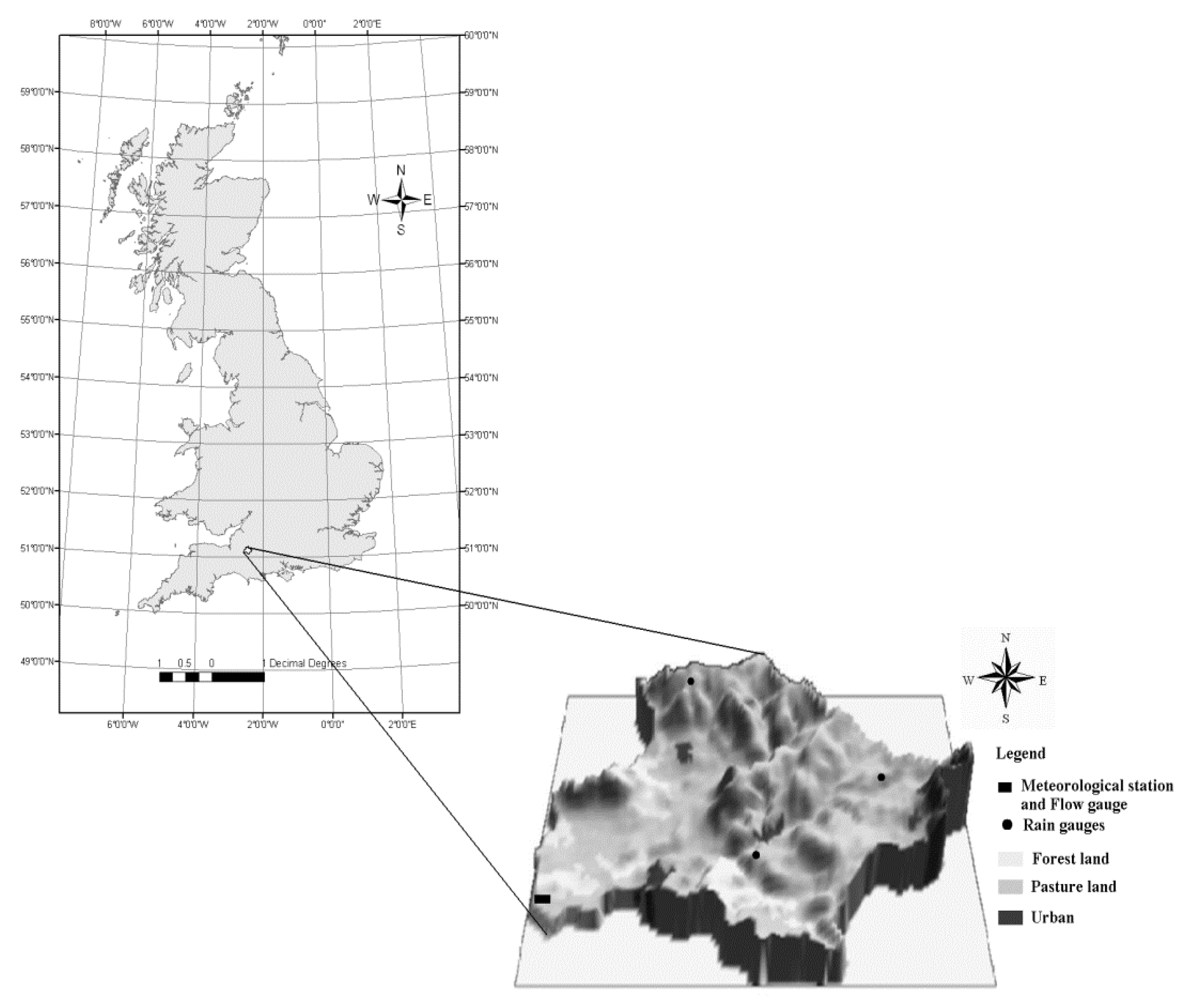
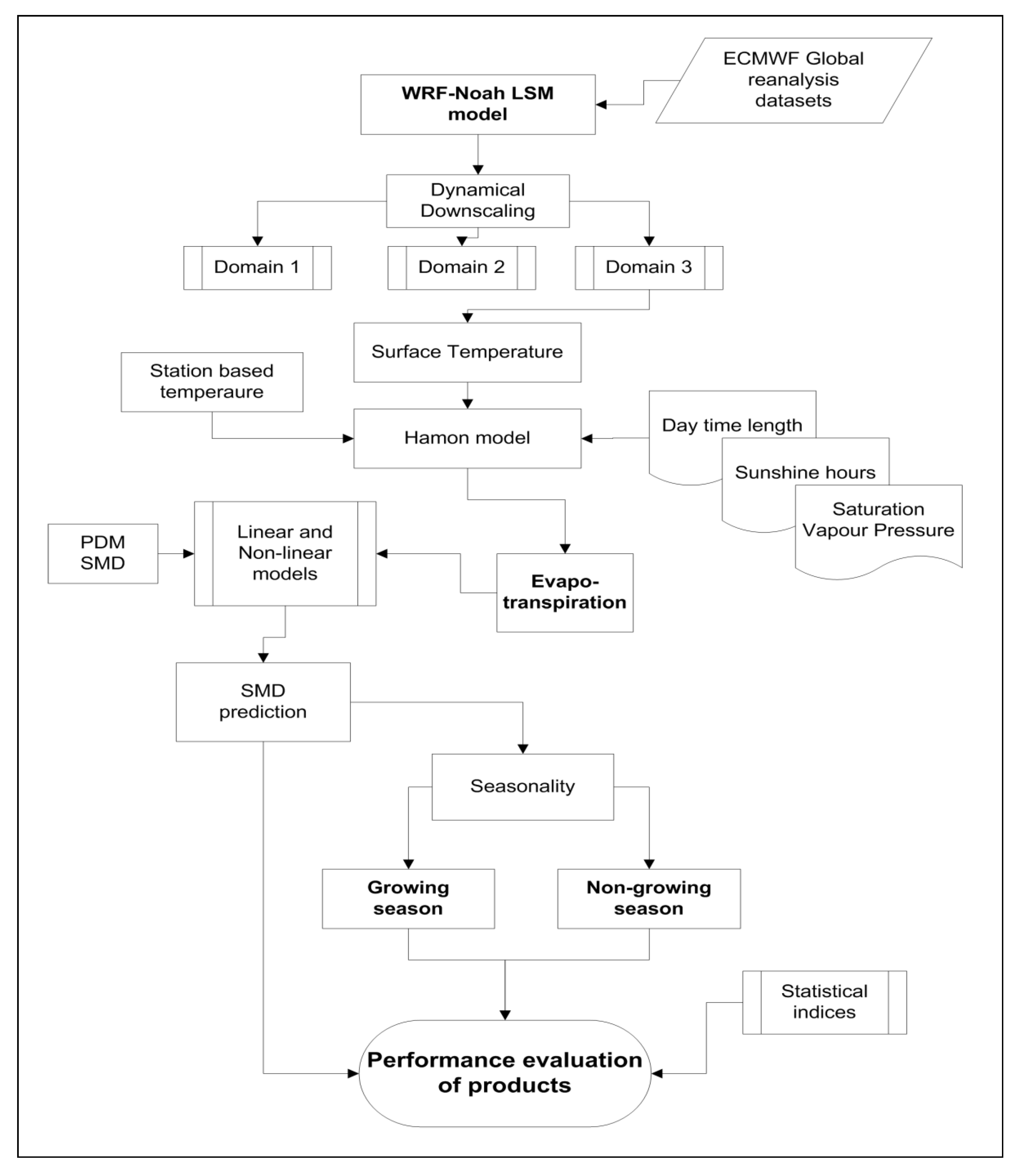
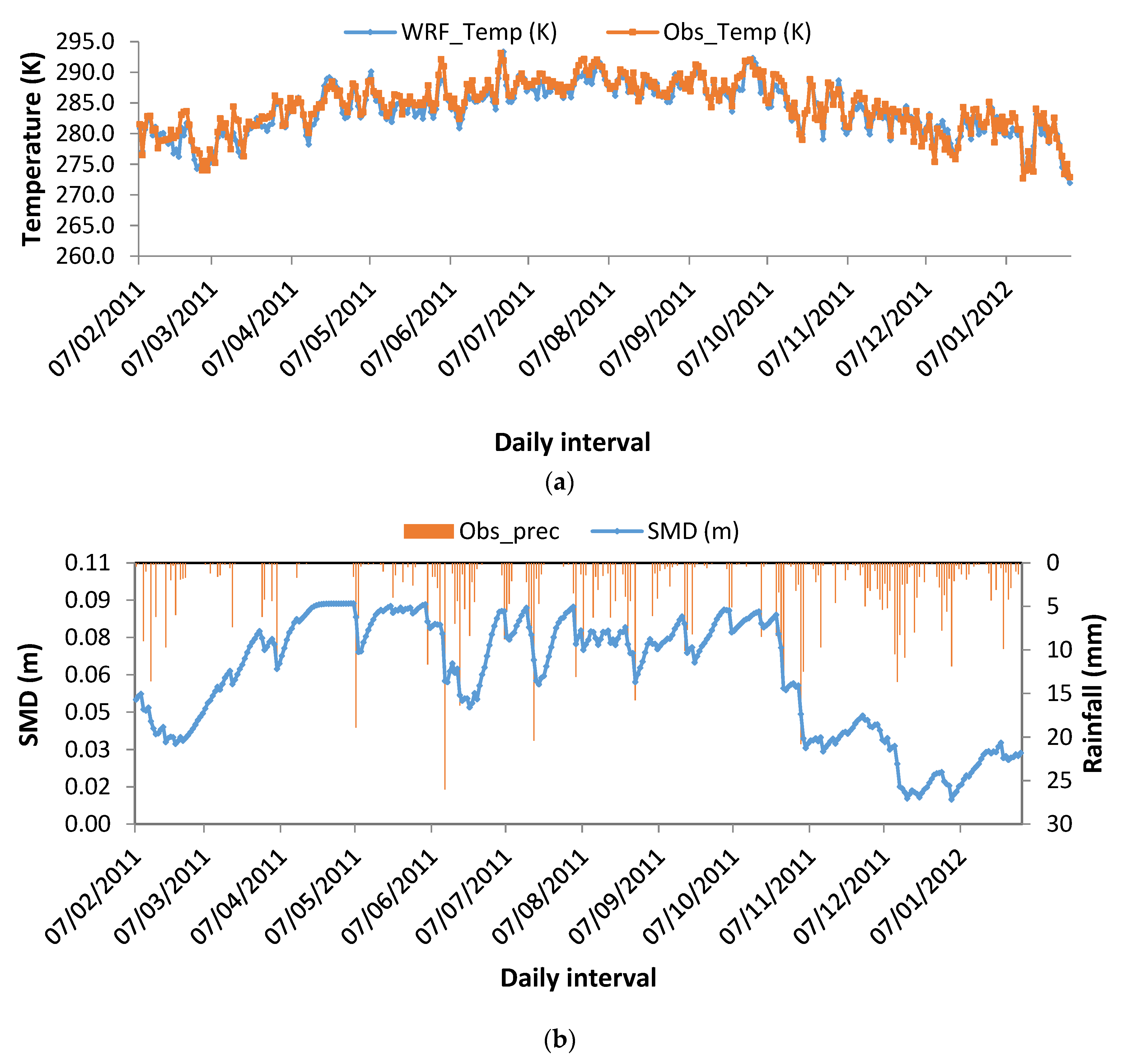
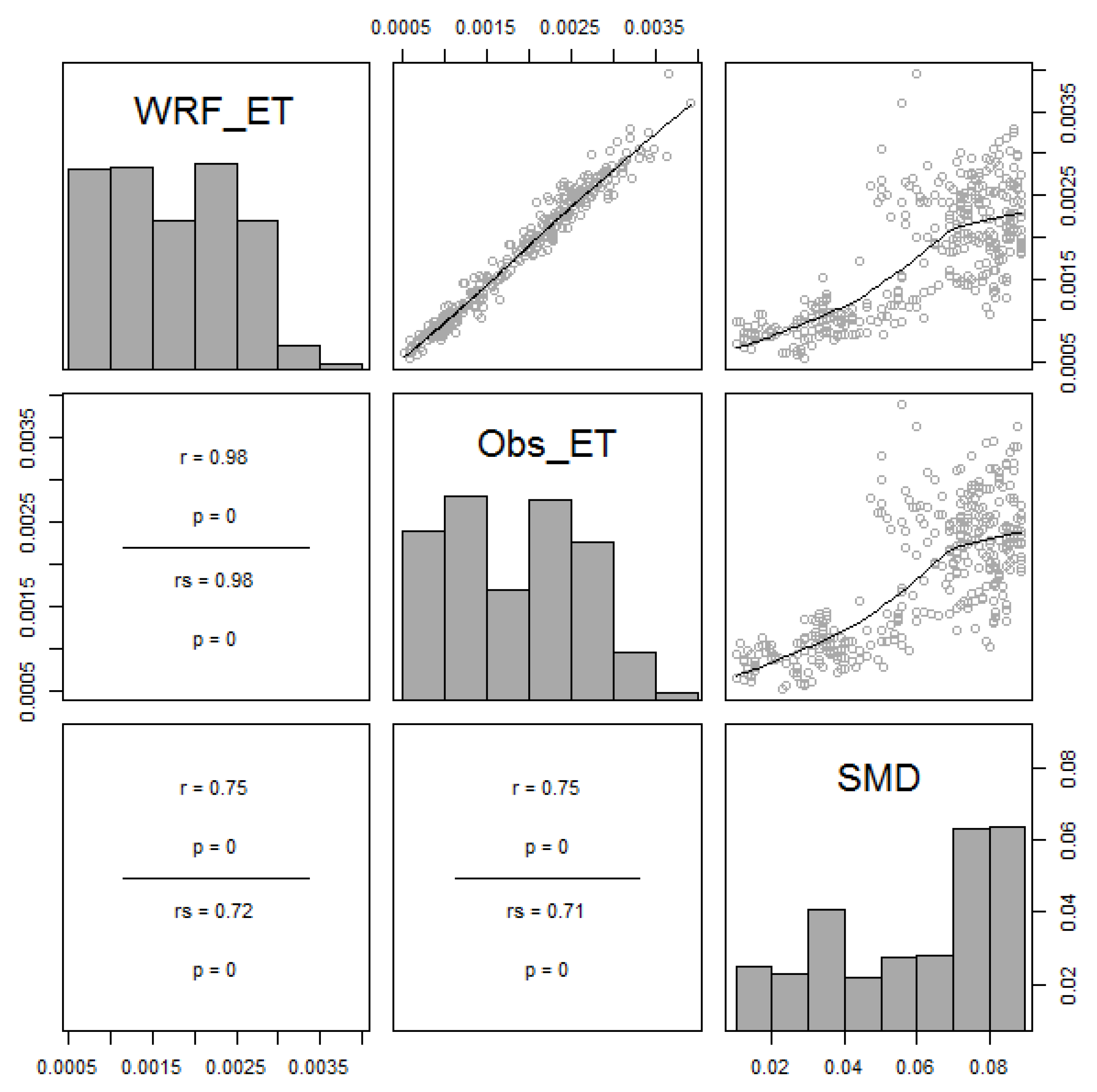


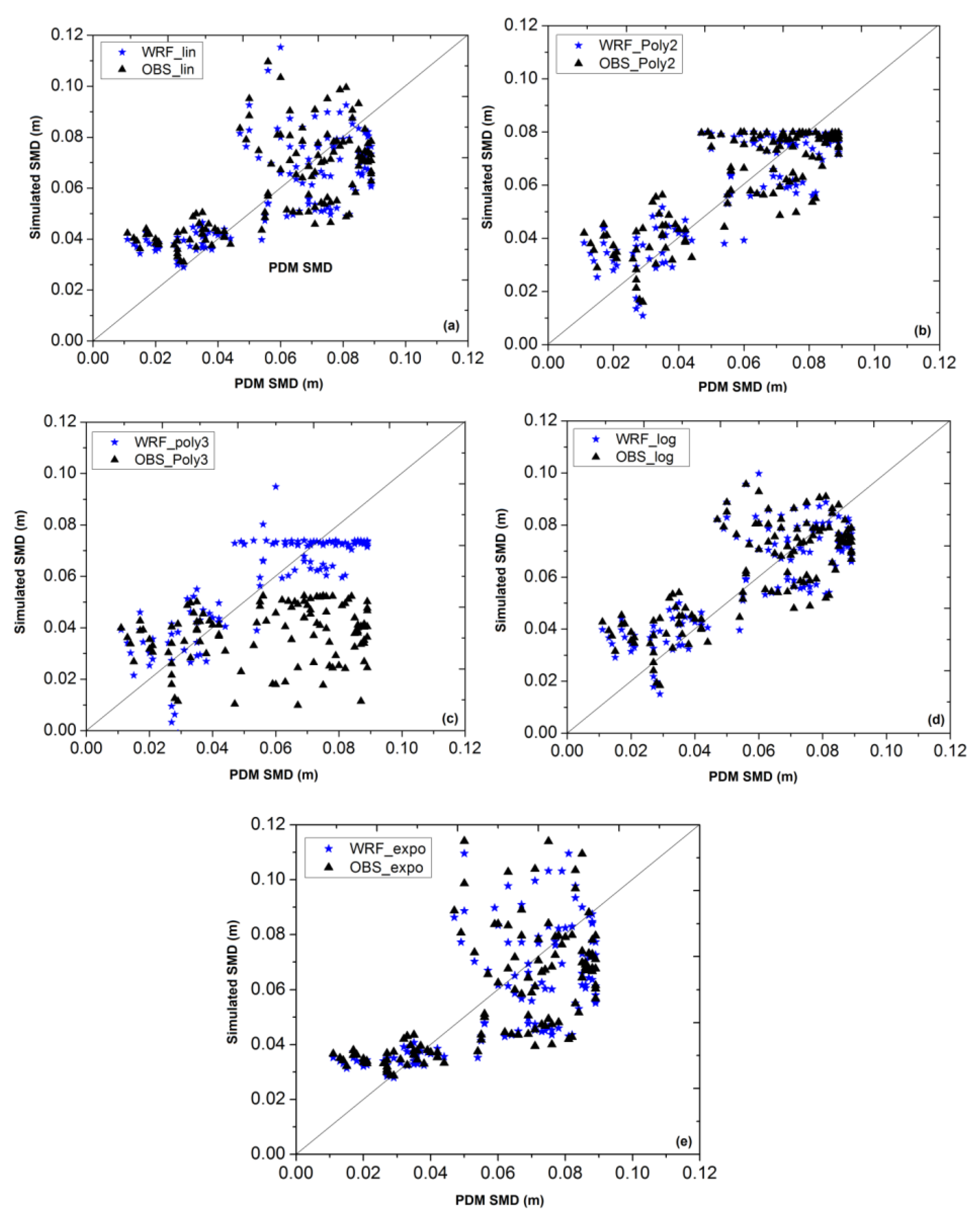
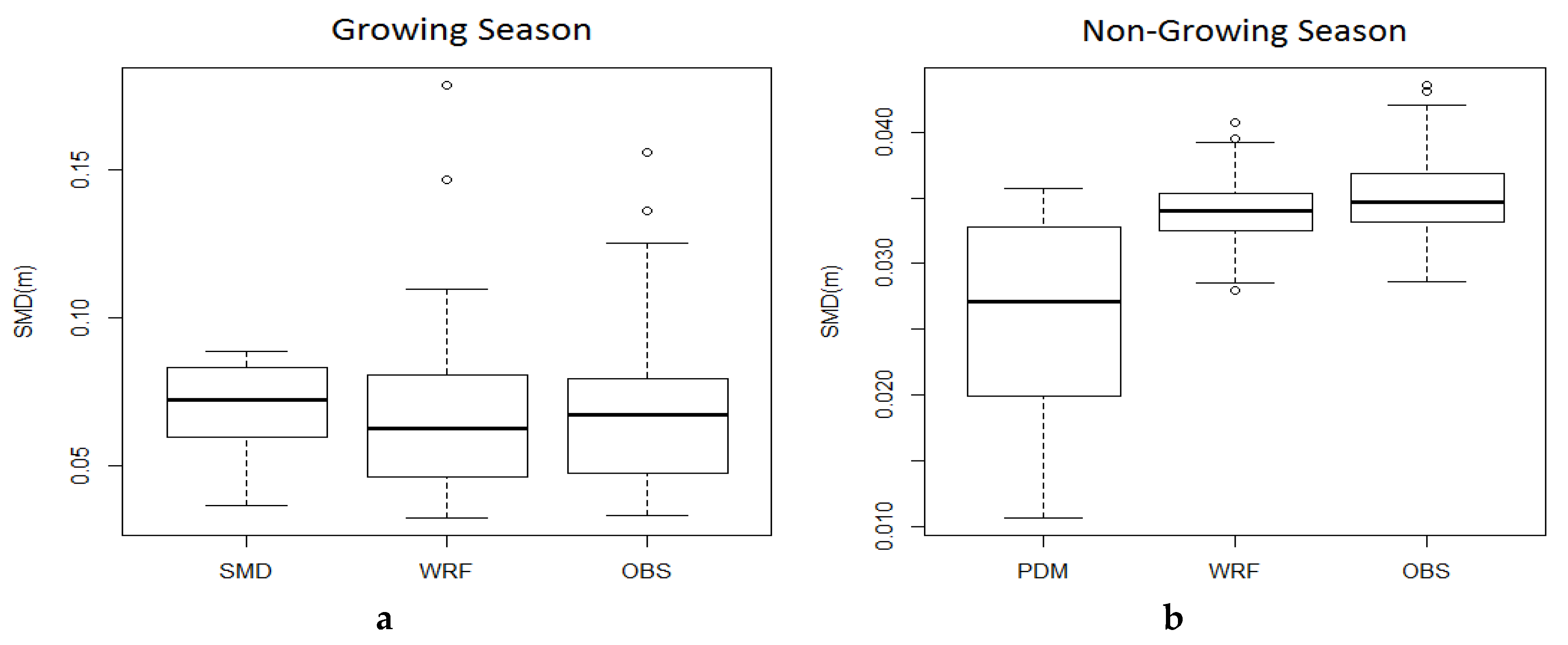
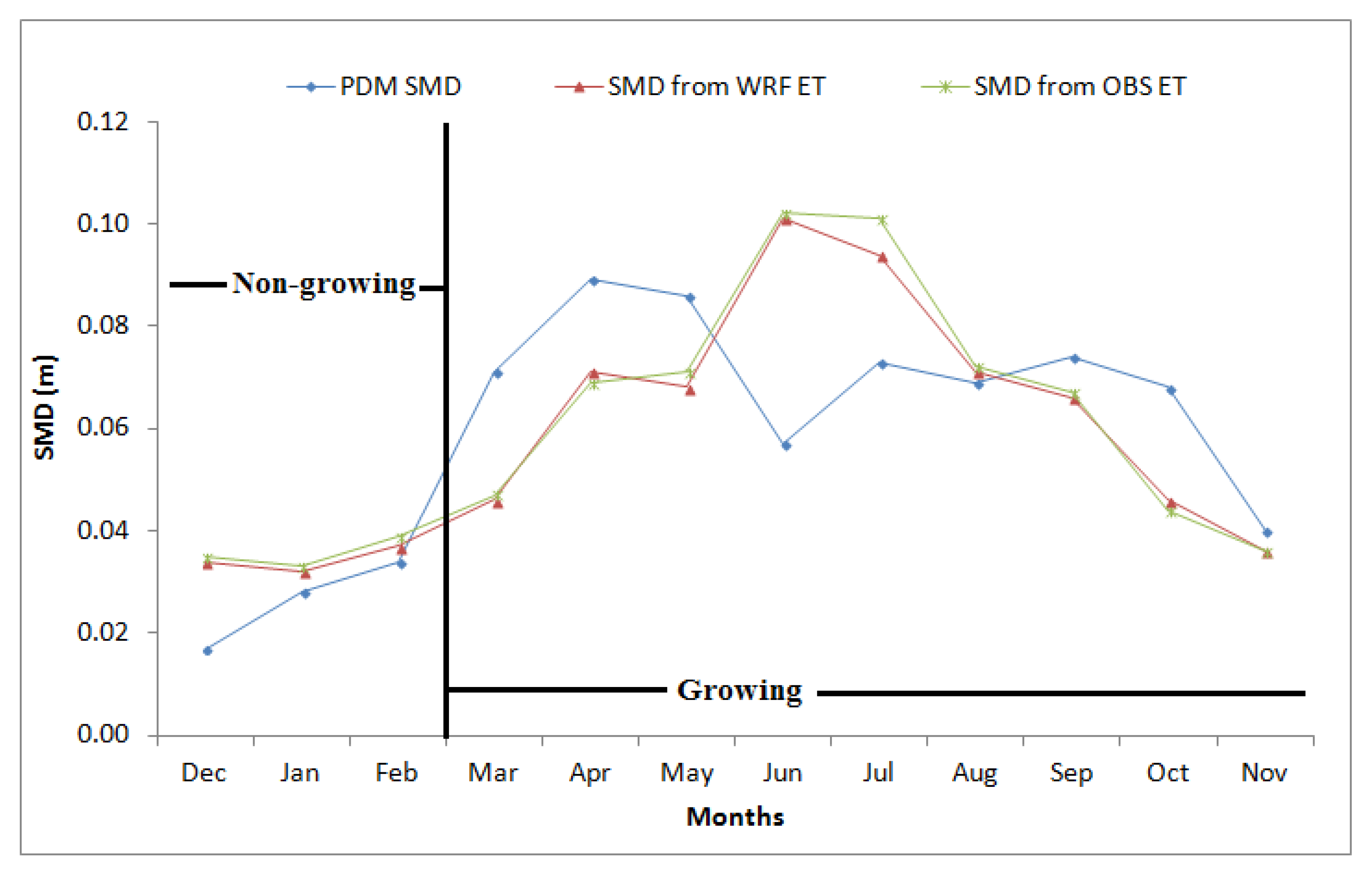

| Initial conditions | Three-dimensional real-data (1° × 1° FNL) |
| Map projection | Lambert |
| Central point of Domain | Central Latitude: 51.11° N; Central longitude: 2.47° E |
| Domain | Three Domains |
| Horizontal grid distribution | Arakawa C-grid |
| Horizontal grid distance | Domain 3 (9 km) |
| NCEP Time interval | 6 hr |
| Model output | Hourly |
| Nesting | 2 way |
| Time integration | 3rd-order Runge-Kutta |
| Spatial differencing scheme | 6th-order centered differencing |
| Lateral boundary condition | Specified options for real-data |
| Top boundary condition | Gravity wave absorbing (diffusion or Rayleigh damping) |
| Bottom boundary condition | Physical or free-slip |
| Microphysics | Lin |
| Radiation scheme | Dudhia’s short wave radiation/RRTM long wave |
| Surface layer parameterization | Thermal diffusion scheme |
| Cumulus parameterization schemes | Betts-Miller-Janjic |
| PBL parameterization | YSU scheme |
| Vertical coordinate | Terrain following hydrostatic pressure coordinate ( 28 sigma levels up to 1 hPa ) |
| S. No. | Model | Observed ETo and SMD | WRF ETo and SMD | ||
|---|---|---|---|---|---|
| Equation | R2 | Equation | R2 | ||
| 1 | Linear | 23.765X + 0.017 | 0.614 | 25.356X + 0.016 | 0.614 |
| 2 | Polynomial 2 | −14672X2 + 78.51X − 0.025 | 0.722 | −18645X2 + 92.398X − 0.034 | 0.731 |
| 3 | Polynomial 3 | 1E + 07X3 − 76942X2 − 193.59X − 0.086 | 0.749 | 1E + 07X3 − 76517X2 − 192.76X − 0.084 | 0.739 |
| 4 | Logarithmic | 0.040ln(X) + 0.323 | 0.689 | 0.043ln(X) + 0.338 | 0.693 |
| 5 | Exponential | 0.0212e511.7X | 0.553 | 0.0207e544.27X | 0.549 |
| S. No. | Model | Observed ETo and SMD | WRF ETo and SMD | ||||
|---|---|---|---|---|---|---|---|
| RMSE | %Bias | NSE | RMSE | %Bias | NSE | ||
| 1 | Linear | 0.019 | 5.149 | 0.419 | 0.017 | 5.280 | 0.448 |
| 2 | Polynomial 2 | 0.667 | 3.568 | 0.013 | 0.707 | 1.934 | 0.013 |
| 3 | Polynomial 3 | 0.627 | 2.821 | 0.014 | 0.679 | −0.207 | 0.013 |
| 4 | Logarithmic | 0.535 | 6.894 | 0.016 | 0.589 | 2.744 | 0.015 |
| 5 | Exponential | 0.226 | −0.077 | 0.616 | 0.022 | −6.088 | 0.149 |
| Variables | Growing | Non-Growing | ||||
|---|---|---|---|---|---|---|
| RMSE | r | %Bias | RMSE | r | %Bias | |
| WRF ETo and PDM SMD | 0.025 | 0.245 | −4.982 | 0.012 | 0.161 | 33.073 |
| Obs ETo and PDM SMD | 0.024 | 0.281 | −3.431 | 0.011 | 0.244 | 32.701 |
© 2017 by the authors. Licensee MDPI, Basel, Switzerland. This article is an open access article distributed under the terms and conditions of the Creative Commons Attribution (CC BY) license (http://creativecommons.org/licenses/by/4.0/).
Share and Cite
Srivastava, P.K.; Han, D.; Yaduvanshi, A.; Petropoulos, G.P.; Singh, S.K.; Mall, R.K.; Prasad, R. Reference Evapotranspiration Retrievals from a Mesoscale Model Based Weather Variables for Soil Moisture Deficit Estimation. Sustainability 2017, 9, 1971. https://doi.org/10.3390/su9111971
Srivastava PK, Han D, Yaduvanshi A, Petropoulos GP, Singh SK, Mall RK, Prasad R. Reference Evapotranspiration Retrievals from a Mesoscale Model Based Weather Variables for Soil Moisture Deficit Estimation. Sustainability. 2017; 9(11):1971. https://doi.org/10.3390/su9111971
Chicago/Turabian StyleSrivastava, Prashant K., Dawei Han, Aradhana Yaduvanshi, George P. Petropoulos, Sudhir Kumar Singh, Rajesh Kumar Mall, and Rajendra Prasad. 2017. "Reference Evapotranspiration Retrievals from a Mesoscale Model Based Weather Variables for Soil Moisture Deficit Estimation" Sustainability 9, no. 11: 1971. https://doi.org/10.3390/su9111971






